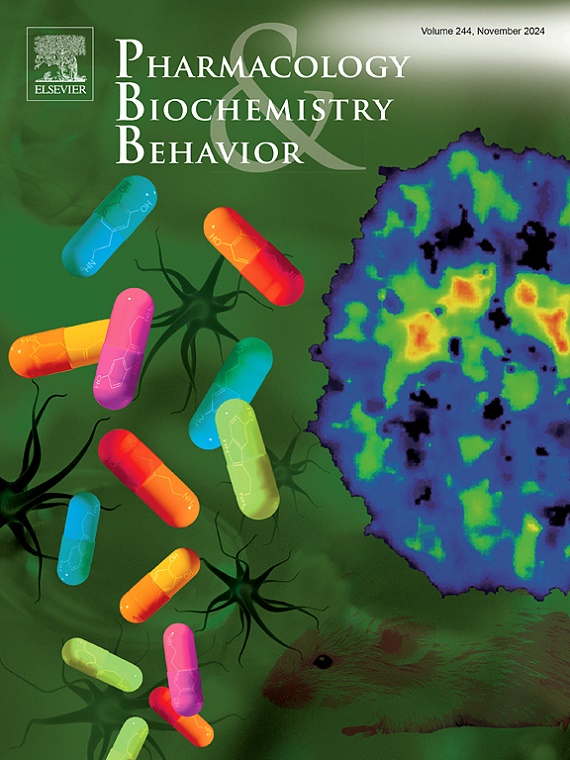围产期跑步训练可逆转小鼠在产前亚慢性可变应激后的产后焦虑和抑郁样行为以及认知障碍。
IF 3.3
3区 心理学
Q1 BEHAVIORAL SCIENCES
引用次数: 0
摘要
背景:怀孕对女性来说是一个非常复杂和高度紧张的时期。尽管产后抑郁症的发病率很高,但仍有 50% 以上的母亲未得到诊断或治疗,这表明迫切需要探索一种有效的预防策略。有研究表明,经常参加体育锻炼与提高孕妇和产后妇女的生活质量有关。本研究旨在确定围产期跑步训练是否能影响产妇护理压力相关焦虑、抑郁样行为和产后大鼠的认知变化,并探讨其可能的内在机制。方法:将40只雌性C57BL/6J小鼠分为四组:产前对照(NC)和跑步训练(EX)组(NC+EX)、产前对照和非跑步训练(RE)组(NC+RE)、产前亚慢性可变应激(SCVS)和跑步训练组(SCVS+EX)以及产前SCVS和非跑步训练组(SCVS+RE)。产前应激组的小鼠在确认怀孕后接受SCVS。跑步训练组的小鼠在整个孕期和哺乳期接受跑步训练。分娩后,测试母性行为、认知变化、焦虑和抑郁样行为。然后,我们测量了母鼠的血清催乳素(PRL)、下丘脑-垂体-肾上腺(HPA)轴活动和成年海马神经发生(AHN):结果:与NC+RE相比,产前SCVS会导致SCVS+RE母体的认知障碍、母性行为下降、焦虑和抑郁样行为,并伴随着HPA轴活性的增加以及产后PRL水平和AHN的下降。与SCVS+RE相比,围产期跑步训练减轻了SCVS+EX母体的认知障碍,增加了母性行为,缓解了焦虑和抑郁样行为,同时降低了HPA轴活性,增加了产后PRL水平和AHN:总之,本研究表明,围产期跑步训练可改善产妇护理,逆转产前应激相关的认知障碍以及产后焦虑和抑郁样行为。本文章由计算机程序翻译,如有差异,请以英文原文为准。
Perinatal running training reversed postnatal anxiety and depressive-like behavior and cognitive impairment in mice following prenatal subchronic variable stress
Background
Pregnancy is a very complex and highly stressful time in women. Despite the high prevalence of postpartum depression, more than 50 % of mothers are undiagnosed or untreated, showing an urgent need to explore an effective preventive strategy. Regular physical activity has been suggested to be associated with an increased quality of life in pregnant and postpartum women. The purpose of this study was to determine whether perinatal running training can affect maternal care stress-related anxiety, depressive-like behavior, and cognitive changes in postpartum dams and to explore the possible underlying mechanism.
Methods
40 female C57BL/6J mice were divided into four groups: prenatal control (NC) and running training (EX) group (NC+EX), prenatal control and nonrunning training (RE) group (NC+RE), prenatal subchronic variable stress (SCVS) and running training group (SCVS+EX) and prenatal SCVS and non-running training group (SCVS+RE). Mice in prenatal stress groups were subjected to SCVS after pregnancy confirmed. Mice in running training groups subjected to running training throughout pregnancy and lactation. Then after the delivery, maternal behavior, cognitive changes, anxiety and depressive-like behaviors were tested. Then we measured the serum prolactin (PRL), hypothalamic–pituitary adrenal (HPA) axis activity, and adult hippocampus neurogenesis (AHN) in dams.
Results
Compared to NC+RE, prenatal SCVS caused cognitive impairments, the decrease in maternal behavior, and anxiety and depressive-like behavior in SCVS+RE dams, accompanying increase in HPA axis activity and decreased the PRL levels and AHN in postpartum period. Then compared to SCVS+RE, perinatal running training mitigates cognitive impairments, increased maternal behavior, and alleviates anxiety and depressive-like behavior in SCVS+EX dams, accompanying the decreased HPA axis activity, and the increased PRL levels and AHN in postpartum period.
Conclusion
Overall, this study suggests that perinatal running training might improve maternal care and reverse prenatal stress-related cognitive impairment and anxiety and depressive-like behavior in postpartum dams.
求助全文
通过发布文献求助,成功后即可免费获取论文全文。
去求助
来源期刊
CiteScore
6.40
自引率
2.80%
发文量
122
审稿时长
38 days
期刊介绍:
Pharmacology Biochemistry & Behavior publishes original reports in the areas of pharmacology and biochemistry in which the primary emphasis and theoretical context are behavioral. Contributions may involve clinical, preclinical, or basic research. Purely biochemical or toxicology studies will not be published. Papers describing the behavioral effects of novel drugs in models of psychiatric, neurological and cognitive disorders, and central pain must include a positive control unless the paper is on a disease where such a drug is not available yet. Papers focusing on physiological processes (e.g., peripheral pain mechanisms, body temperature regulation, seizure activity) are not accepted as we would like to retain the focus of Pharmacology Biochemistry & Behavior on behavior and its interaction with the biochemistry and neurochemistry of the central nervous system. Papers describing the effects of plant materials are generally not considered, unless the active ingredients are studied, the extraction method is well described, the doses tested are known, and clear and definite experimental evidence on the mechanism of action of the active ingredients is provided.

 求助内容:
求助内容: 应助结果提醒方式:
应助结果提醒方式:


